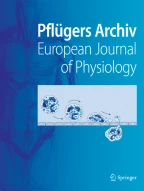Abstract
In endothelial cells, different types of Ca2+ conductances have been described, but none of them has been clearly identified as I CRAC, the Ca2+ release-activated Ca2+ current originally described in mast and lymphoma cells. Here we show that in bovine pulmonary artery endothelial cells (CPAE) depletion of intracellular Ca2+ stores by inositol 1,4,5-trisphosphate (InsP 3), Ca2+ ionophores and Ca2+ pump inhibitors activates a Ca2+-selective conductance in the presence of the Ca2+ chelator 1,2-bis(2-aminophenoxy)ethane-N,N,N′,N′-tetraacetic acid (BAPTA). The current shows inward rectification, a highly positive reversal potential and is blocked by micromolar concentrations of La3+. The conditions used in studies of endothelial cells were also employed in those of HEK-293, an embryonic kidney cell line commonly used to express putative store-operated channels, and Jurkat cells, the reference cell model. Similar to CPAE, HEK cells also have an I CRAC-like current. At 0 mV holding potential the estimated current density is –0.1 and –0.2 pA/pF in CPAE and HEK cells respectively, i.e. 15 and 30% of that measured in Jurkat cells. As shown in studies of Jurkat cells, larger Na+ currents are detectable in CPAE and HEK cells following store depletion in Ca2+- and Mg2+-free medium. The current carried by Na+ ions is similarly blocked by micromolar La3+, is inwardly rectifying and has a positive reversal potential.
Similar content being viewed by others
Author information
Authors and Affiliations
Additional information
Received: 12 November 1997 / Received after revision: 11 February 1998 / Accepted: 12 February 1998
Rights and permissions
About this article
Cite this article
Fasolato, C., Nilius, B. Store depletion triggers the calcium release-activated calcium current (I CRAC) in macrovascular endothelial cells: a comparison with Jurkat and embryonic kidney cell lines. Pflügers Arch 436, 69–74 (1998). https://doi.org/10.1007/s004240050605
Issue Date:
DOI: https://doi.org/10.1007/s004240050605
